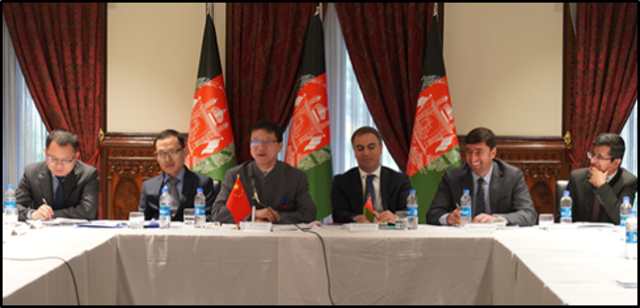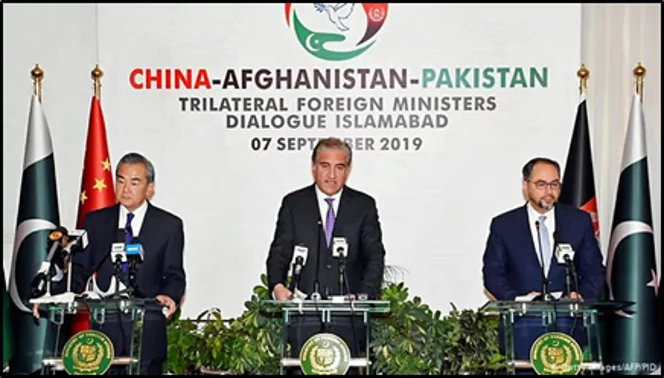
China’s Deepening Diplomatic and Economic Engagement in Afghanistan
Publication: China Brief Volume: 20 Issue: 6
By:

Introduction
On February 29, U.S. and Taliban representatives signed the “Agreement for Bringing Peace to Afghanistan” in Doha, Qatar, which laid out a framework for ending the 18-year old conflict in Afghanistan (U.S. State Department, February 29). Despite skepticism in many quarters regarding the viability of the deal, the negotiations leading to the agreement have been supported by many international actors, to include the government of the People’s Republic of China (PRC). On February 18, PRC Foreign Ministry spokesman Geng Shuang (耿爽) commented on the U.S.-Taliban negotiations by stating that “China firmly supports the broad and inclusive peace and reconciliation process [and] welcomes the news that the U.S. and the Taliban are expected to reach and sign a deal… China stands ready to step up cooperation with all parties to the Afghan issue and the international community for peace, stability and development in Afghanistan” (PRC Foreign Ministry Briefing, February 18).
As the U.S plans to draw down its forces in Afghanistan—a key element of the February 29 deal—China is set to further deepen its involvement in Afghanistan (Nikkei Asian Review, January 14, 2019). Beijing wishes to achieve at least two key objectives. First, it wants once and for all to block any contact between the Taliban and ethnic Uighur Muslim militants seeking independence from China (China Brief, April 24, 2019). Second, the PRC wants long-term stability in Afghanistan in order to extend the China-Pakistan Economic Corridor (CPEC)—the flagship project of China’s Belt and Road Initiative (BRI)—to the war-wracked country. Beijing sees Afghanistan as a primary link between the Central Asian republics and the CPEC (China Brief, December 10, 2019). To achieve its objectives, Beijing has pursued positive engagement with the Taliban movement that controls more than half of Afghanistan’s territory. These ties have increased over the past couple of years: for example, in 2019 Taliban representatives paid at least two visits to Beijing (in June and September) for talks with PRC officials (CGTN, June 20, 2019; Al-Jazeera, September 23, 2019).

China’s Interests in Afghanistan
With multi-billion dollar investments in different development projects, China is the largest foreign investor in Afghanistan. China has adopted a two-step process over the past twelve years to increase its stake in Afghanistan: first investments, followed by political engagement. The PRC first entered Afghanistan as a major investor and developer in 2007, when it won a $3.5 billion contract to operate the Ayanak copper-gold mine in the country’s eastern Logar Province (SCMP, March 20, 2014). Then, it also invested in oil and gas exploration projects and railway infrastructure development in the war-torn country. On the political front, Beijing made contacts with both the Afghan government and Taliban to promote a political settlement of the conflict—particularly after U.S President Donald Trump cancelled peace talks with the Taliban last September.
Beijing has played an active role in the run up to the Afghan endgame, as it has aspired to assume a greater role in Afghanistan after the U.S military withdrawal. China’s economic interests in Afghanistan coincide with its wider plans: to develop western China, increase regional trade links, build energy pipelines, and expand its economic influence in the region. The PRC is likely to deepen its strategic partnership with Pakistan and Afghanistan to form a “Pamir Group” in order to establish a new Silk Road linking the Caucasus to western China. Historically, the Pamir Mountains were considered a strategic trade route between Kashgar in China, and Kokand in Uzbekistan on the Northern Silk Road (Al Araby, January 30).
Both geographically and geopolitically, China enjoys a favorable environment to increase its stakes in Afghanistan. China shares a small border with Afghanistan through the Wakhan Corridor, a buffer zone created in the 19th century to separate the Russian empire and British empire. Furthermore, the regional powers surrounding Afghanistan generally have good relations with the PRC, and favor China’s increased involvement in the war-battered country:
- Pakistan is China’s closest strategic ally, and host to the massive CPEC program (China Brief, January 5, 2019; China Brief, January 17);
- Iran is seeking to deepen its strategic ties with China amid rising tensions with the United States (China Brief, January 17; China Brief, March 16);
- Tajikistan is among the states that first joined the BRI, and also hosts a de facto PRC military base in the far eastern part of the country (East Asia Forum, March 23, 2019).
The PRC has now emerged as a key political player in Afghanistan—and after the withdrawal of U.S. troops, China may be expected to play an even more active role. The Trump Administration’s Afghan policy has been inconsistent, with sudden U-turns—which in turn has paved the way for China to deepen its involvement in the war-torn country. An initial one-year round of peace talks between the U.S and Taliban ended in failure, due to the sudden cancellation of the talks by President Trump in September 2019 (BBC, September 9, 2019). Immediately afterwards, the PRC moved to boost its own diplomatic profile in the peace process during the month of October: first announcing its intent to host talks between the Afghan government and Taliban (SCMP, October 23, 2019), and then joining in Russia-China-Pakistan-United States discussions on Afghanistan held in Moscow (Xinhua, October 26, 2019).
The U.S.-Taliban talks resumed last December, leading ultimately to the February 2020 agreement. The three-month gap created space for the PRC to increase its reconciliation role in Afghanistan, and Beijing contacted both Afghan officials and the Taliban during this period. Presently, China is committed to host a meeting between the Afghan government and Taliban—a key U.S demand that has been rejected by the Taliban, which derides the Afghan government as a U.S. puppet. If this were to occur, it would mean that, after the withdrawal of U.S. troops from Afghanistan, the actual political settlement process would be initiated and led by Beijing.
In the diplomatic arena, Pakistan is China’s major trump card for enhancing its political profile in Afghanistan. Pakistan is believed to have played a major behind-the-scenes role in brokering China-Taliban peace consultations. In October 2018, the late Maulana Sami ul Haq, a stalwart Afghan Taliban supporter, called on China to play a greater role in the Afghan peace negotiations. Popularly known as “Father of the Taliban” (Jamestown, May 23, 2007), Maulana invited Beijing to play the role of arbitrator to the Afghan conflict. He advocated increased Chinese engagement because of China’s stakes in the region, and stated that China should not leave Afghanistan-related matters solely to the United States. Thanks to leveraging such contacts through its closest ally Pakistan, the PRC developed backdoor communication links with the Taliban (Express Tribune (PK), November 2, 2019).

Afghanistan Emerging as China’s Vital Partner in the BRI
Afghanistan was not initially included in the map of China’s trillion-dollar BRI program when it was launched in 2013. Instead of Afghanistan, BRI plans focused on Pakistan and Central Asia. In recent years, however, Beijing has shifted focus and increased its stakes in Afghanistan, which sorely needs infrastructure development projects. Afghanistan’s potential role in the BRI has been discussed in a report by the Organization for Policy Research and Development Studies (DROPS), a Kabul-based think tank. The report highlights potential roles for the war-battered country that fits well into the BRI. Strategically located Afghanistan provides the shortest route between Central Asia and South Asia, and between China and the Middle East; it can also serve as a gateway to the Arabian Sea. The $60 billion CPEC program contains transportation infrastructure projects that can be extended to Afghanistan, thereby further integrating it into the BRI. [1]
Serious discussions are ongoing to incorporate Afghanistan into the CPEC. In 2017, China convened a trilateral dialogue with Pakistan and Afghanistan intended in part to discuss CPEC expansion into Afghanistan (TRT World, February 18, 2019). In a trilateral foreign ministers’ meeting hosted by Islamabad last September, representatives from the three sides observed that the Peshawar-Kabul Motorway may provide the foundation for Afghanistan’s formal joining of the CPEC, as Peshawar—Pakistan’s largest northwestern city—is already linked with the route. The three sides decided that the motorway project would be pursued under the program of “China-Afghanistan-Pakistan Plus Cooperation” (CAPPC) (Pakistan Today, September 8, 2019; China Brief, December 10, 2019).
Conclusion
For China, the conflict-ridden but strategically located country of Afghanistan could either prove to be a unique opportunity, or a formidable security challenge. Through its increased presence in Afghanistan, the PRC has worked over the past twelve years to convert the security problems emanating from volatile Afghanistan into a strategic and economic opportunity to expand its influence to South and Central Asia—and even further afield to the Middle East and Europe. Afghanistan will likely be formally included in China’s BRI map in the future, as Beijing gradually attains greater economic stakes and diplomatic influence in the war-ravaged country. The PRC may be expected to leverage CPEC to provide a springboard for the extension of its BRI into Afghanistan and Iran, and onwards into the energy-rich Gulf region. Following the withdrawal of U.S. troops, China—with the help of its close ally Pakistan—is set to become a major player in Afghanistan.
Syed Fazl-e-Haider is a contributing analyst at the South Asia desk of Wikistrat. He is a freelance columnist and the author of several books, including The Economic Development of Balochistan (2004). He has contributed articles and analysis to a range of publications including Dawn, The Express Tribune, Asia Times, The National (UAE), Foreign Affairs, Daily Beast, New York Times, Gulf News, South China Morning Post, and The Independent.
Notes
[1] Mariam Safi and Bismellah Alizada, Integrating Afghanistan into the Belt and Road Initiative: Review, Analysis and Prospects, Organization for Policy Research and Development Studies (August 2018). https://www.dropsafghanistan.org/wp-content/uploads/2019/01/Integrating-Afghanistan-into-the-Belt-and-Road-Initiative.pdf.



